Support Page Content
PAL Research
The PAL program is constantly adapting to best serve all students. The best ideas for how to do this often come from students themselves. Consequently, all of our Facilitators design and implement research projects to study what works best for their students. Many Facilitators go on to present their projects or other aspects of the PAL program at national conferences. Sample projects, design details, and a partial list of conferences appear below.
The PAL faculty also regularly analyze the program's effectiveness, measured in many ways. This work involves students, institutional research, and statistics faculty. Some of our data and analyses are published or presented nationally, others are for internal use but available upon request.
Program Effectiveness and Data
Student Posters
All PAL Facilitators conduct year-long research projects as part of our seminar, NSM 197. In the Fall, Facilitators use backwards design to generate ideas for these projects. They start by determining something they want their students to know, understand, or be able to do. Then they figure out how they could measure whether this was successful. Lastly, they come up with an intervention to try out in their own classroom which they believe would have the intended effect.
Of the many ideas generated, a handful are chosen and Facilitators self-select into interdisciplinary research teams of 5-10 members. The remainder of the Fall semester consists of developing a rigorous methodology including statistical analysis, and completing an extensive literature review to inform the background of the project.
In the Spring semester, Facilitators carry out the interventions in their classrooms and collect data. Near the end of the semester they analyze their data, draw conclusions, and consider confounding effects and drawbacks to their methods. This is all summarized in a poster, all of which are presented during finals week at the PAL Research Symposium, attended by families and friends, faculty and administrators, community partners and PALumni. Sample posters from recent years appear below.
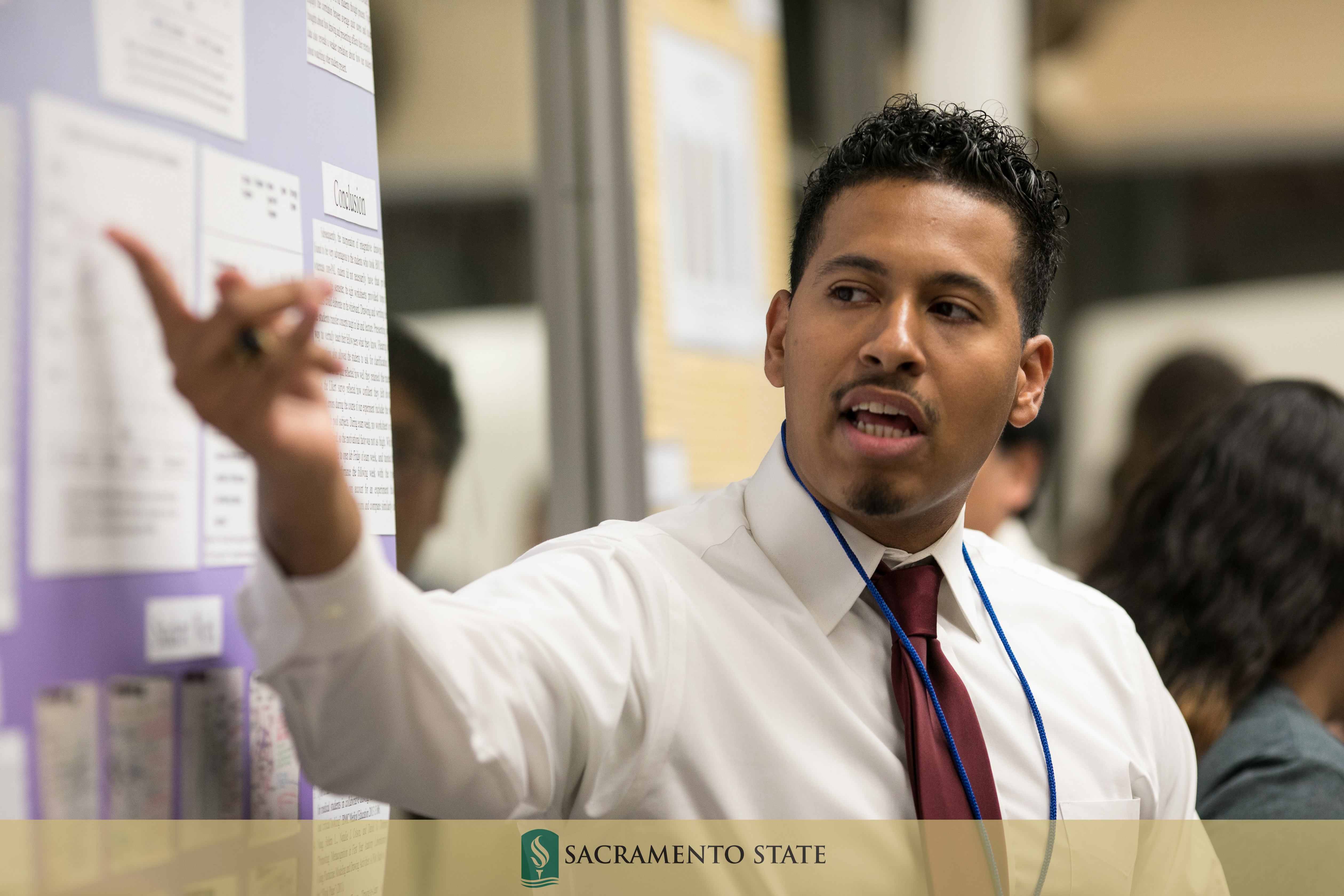
2024-25 Research Projects:
- The Impact of Self-Care on Negative Stress
- Fostering Student Confidence Through Knowledge Reinforcement
- Analyzing the Effect of Attendance on Performance of Academic Assessments
- PAL-opoly Assisted Learning
- Crafting Cheat Sheets: Increasing Student Success Through Facilitated Study Guides
2023-24 Research Projects:
- Exam Ease: Investigating the Impact of Question Dissection
- Discovering the Patterns Across STEM Disciplines
- Effectiveness of Heutagogical Learning Methods in PAL Courses
- Collaborative Notes
- Examining Anxiety Associated with Time-Based Assessments
- Icebreakers' Influence on Peer Connectedness in Peer-Led Team Learning
2022-23 Research Projects:
- Assessment of Understanding and Anxiety Before & After Assistant Facilitation
- Utilizing Calendars to Reduce Student Stress
- Concept Maps' Impact on Learning
- Back to the Basics: How Reinforcing Algebraic Foundations Improves Understanding in STEM Classes
- Pavlov's Office Hours
- Manifesting Exam Scores
- The Effect of Music on Student Mood While Studying in STEM Courses
2021-22 Research Projects:
- Bridging the Social Distance
- The Effect of Self-Care on College Students’ Stress Levels
- Effectiveness of Self-made Mnemonics
- Improvement of Comfortability Through Music
- Investigating if Frustration Changes with Post-class Plans
- The Use of Peer Psuedofacilitators & Revised Bloom’s Hierarchy in Evaluating Course Material Confidence and Student Grades
- The Effects of Preliminary Discussion on Class Performance
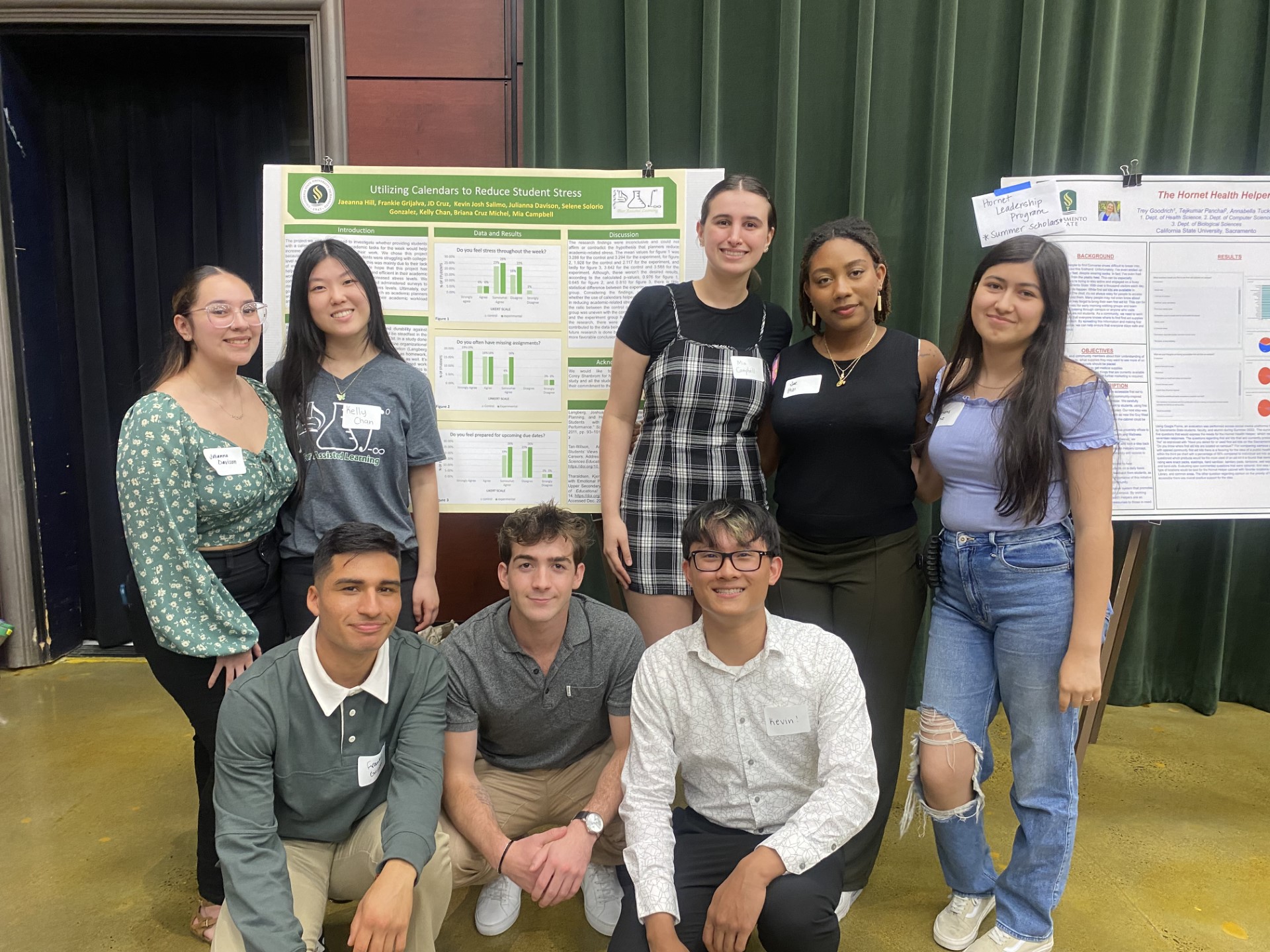
Student Presentations and Publications
Student conference presentations:
PAL Facilitators regularly present both on and off campus. In addition to the PAL Poster Symposium, they often present their research posters above at campus research symposia and poster sessions. But many also have the opportunity to travel to national conferences, presenting on certain aspects of the program or running workshops. Some select examples include:
- PLTLIS, Rochester, 2024
- AHSIE, Best Practices Conference, San Francisco, 2023
- PLTLIS, Dallas, 2018
- AHSIE Best Practices Conference,Chicago, 2018
- AHSIE Best Practices Conference, Las Vegas, 2017
- AAC&U Transforming STEM Higher Education, San Francisco, 2017
- California Peer Leadership Conference, San Diego, 2016
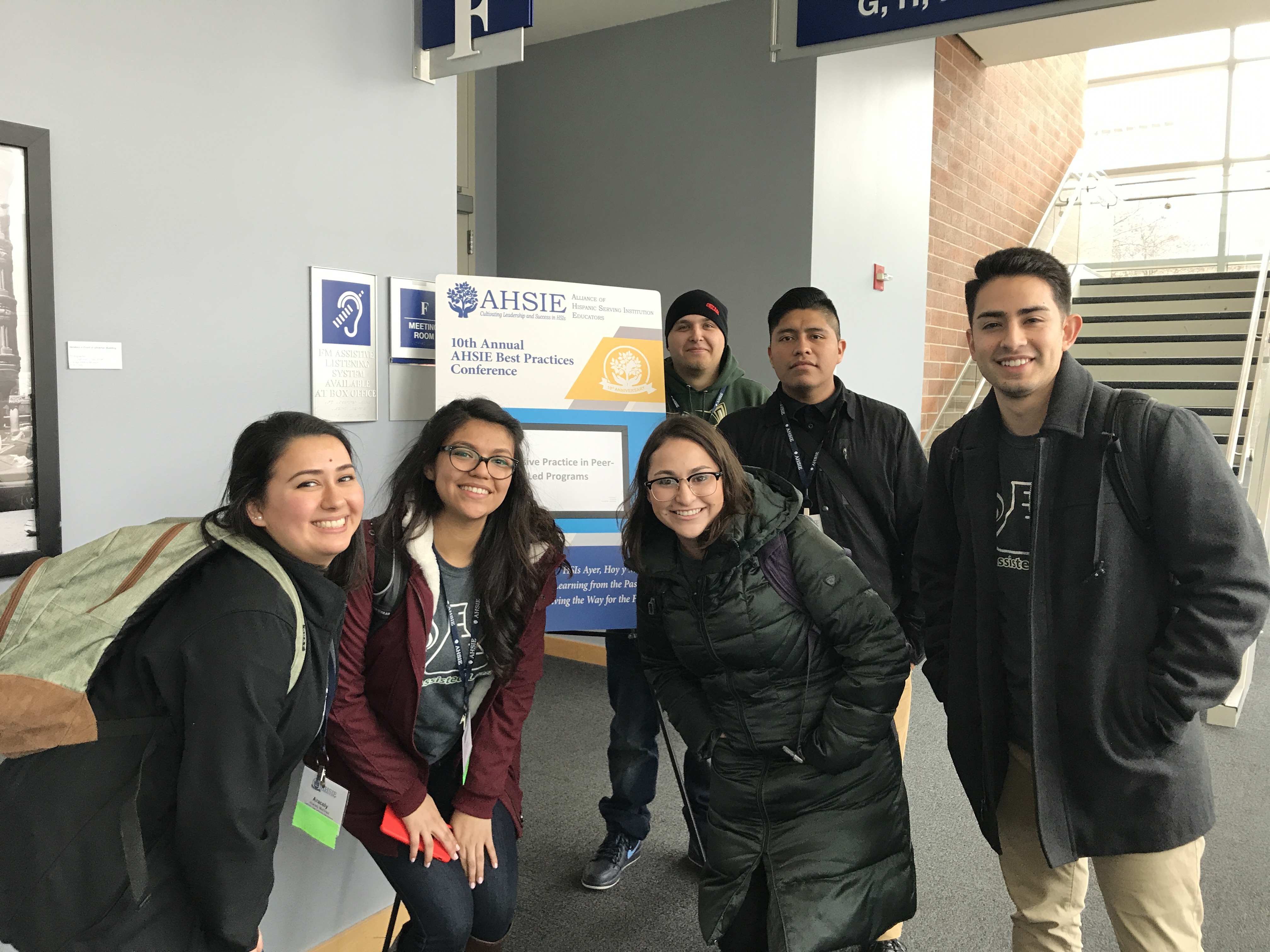
Student publications (all authors are PAL Facilitators):
Akhavan, Davison, Hill, Mosley, Salimo, and Taylor. The Community and Structure of Sacramento State’s Peer Assisted Learning Program. Advances in Peer-Led Learning (2024).
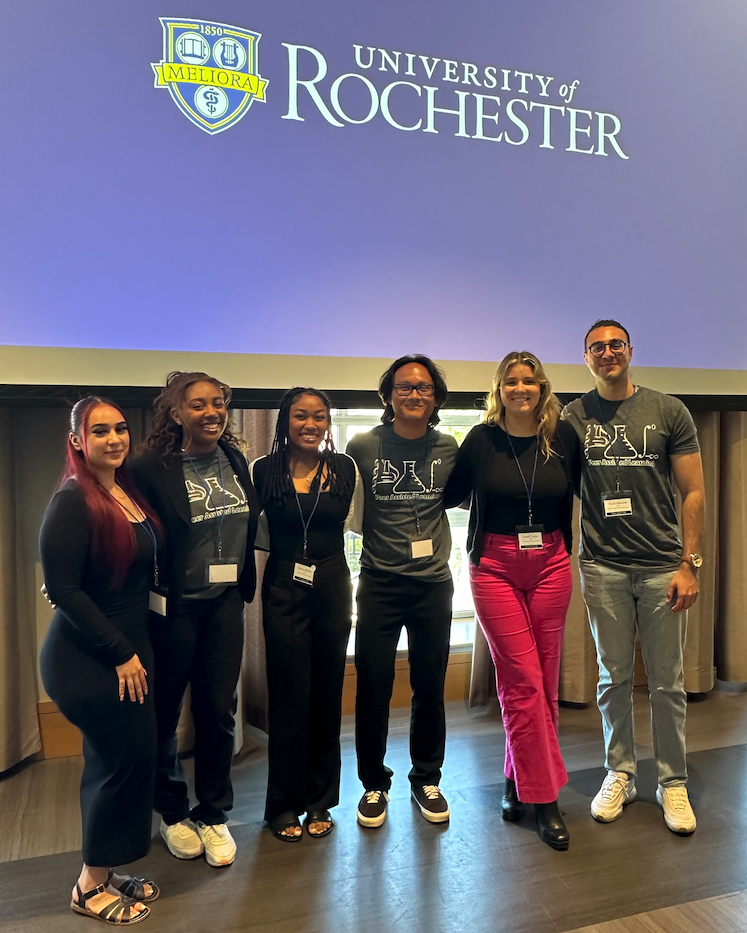
Program Effectiveness and Data
PAL faculty work with undergraduate students, College of NSM faculty, and the office of Institutional Research, Effectiveness, and Planning to continually study the PAL program from different perspectives. While some of our results are provided on this page, we have a wealth of other data which is available upon request. Contact corey.shanbrom@csus.edu for more information.
Much of the PAL program is grant-funded, and rigorous programmatic research allows us to continually compete for large federal grants. In particular, PAL has received major awards from the Department of Education (DoE) and the National Science Foundation (NSF).
In addition to the conferences listed above with student co-presenters, PAL faculty have presented on the program at a variety of venues, including to CSU internal groups (STEM Collaboratives Summit, Math Council Colloquium, Learning Support Directors' Meeting) and international audiences (International Conference on Teaching and Learning, Joint Mathematics Meetings).
Student success:
Our analysis indicates that students opting into PAL earn a 23% “bump” in their course grade. Since PAL is an optional program, we use propensity score matching to compare students with comparable academic and social backgrounds, ensuring that the grade boost is actually due to the students' participation in PAL, and that PAL serves all students. The graph below shows the PAL boost in 11 courses (n=10,333).
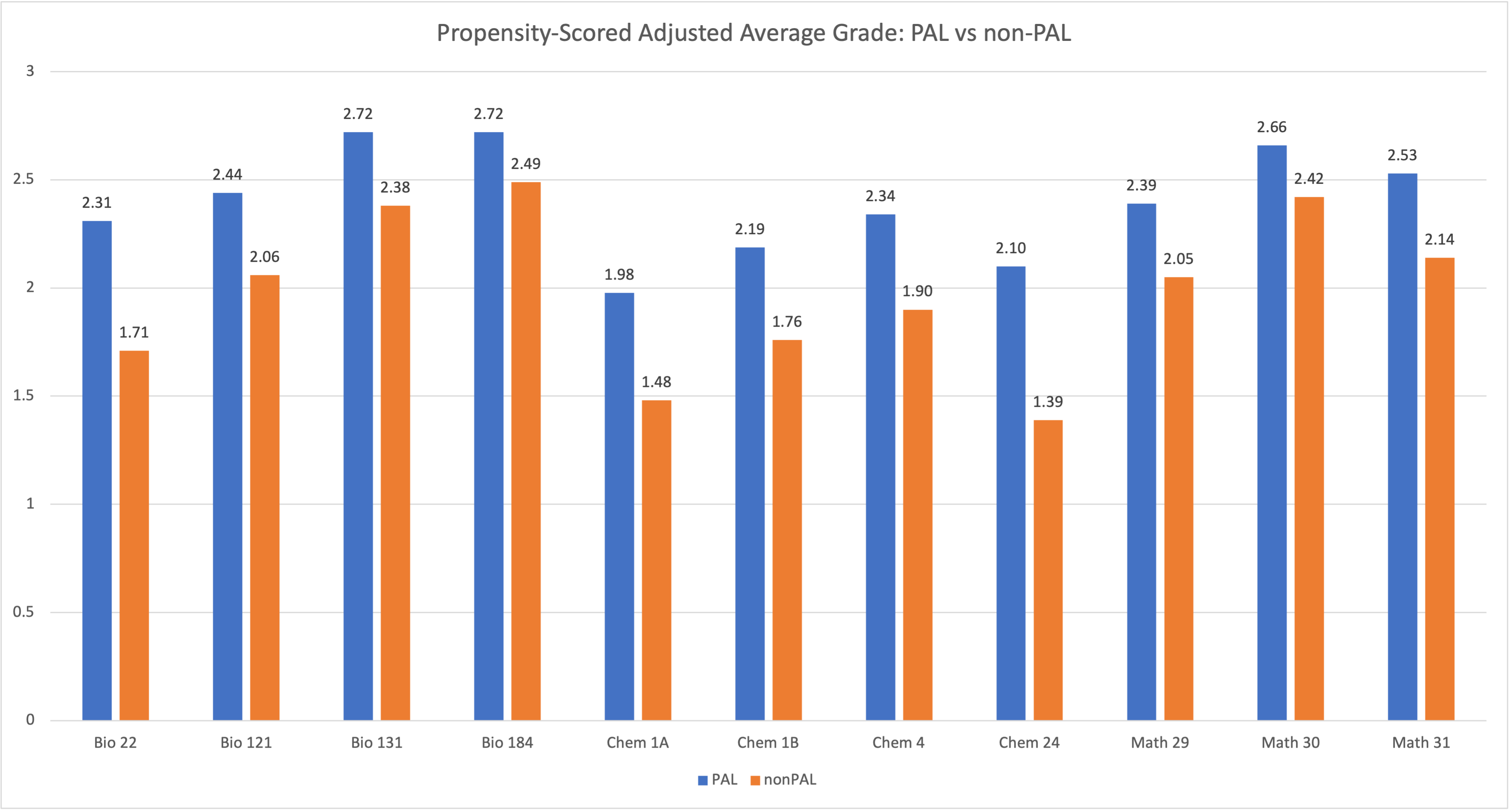
Career success and workplace skills development:
- Survey results for 158 former Facilitators currently in the workforce; mean and median grad year of 2020
- Results on how PAL develops career readiness competencies: 100% of PALumni agreed that PAL helped them develop the skill of Leadership, 99% the skill of Teamwork, 97% the skills of Communication, Critical Thinking, and Career & Self-Development
- Results on how PAL helps students get jobs and become successful; 94% of PALumni say PAL helped them be successful in their job
- Only 1% of PALumni are unemployed (4.5% of college grads nationally). Of those employed, 75% have careers in STEM; 44% have earned a graduate/professional degree (26% of college grads nationally)
- PALumni average salary is $78,732 (national average for class of 2020 is $56,576)
- Complete, unedited free response results:
- What other PAL experiences, if any, helped you develop these skills?
- What other workplace skills, if any, did PAL help you develop?
- What other PAL experiences do you believe helped you get a job?
- What other PAL experiences do you believe helped you be successful in your job?
- In what ways, if any, do you believe PAL helped you be successful in life outside of your career?
Data for Bio 25/26:
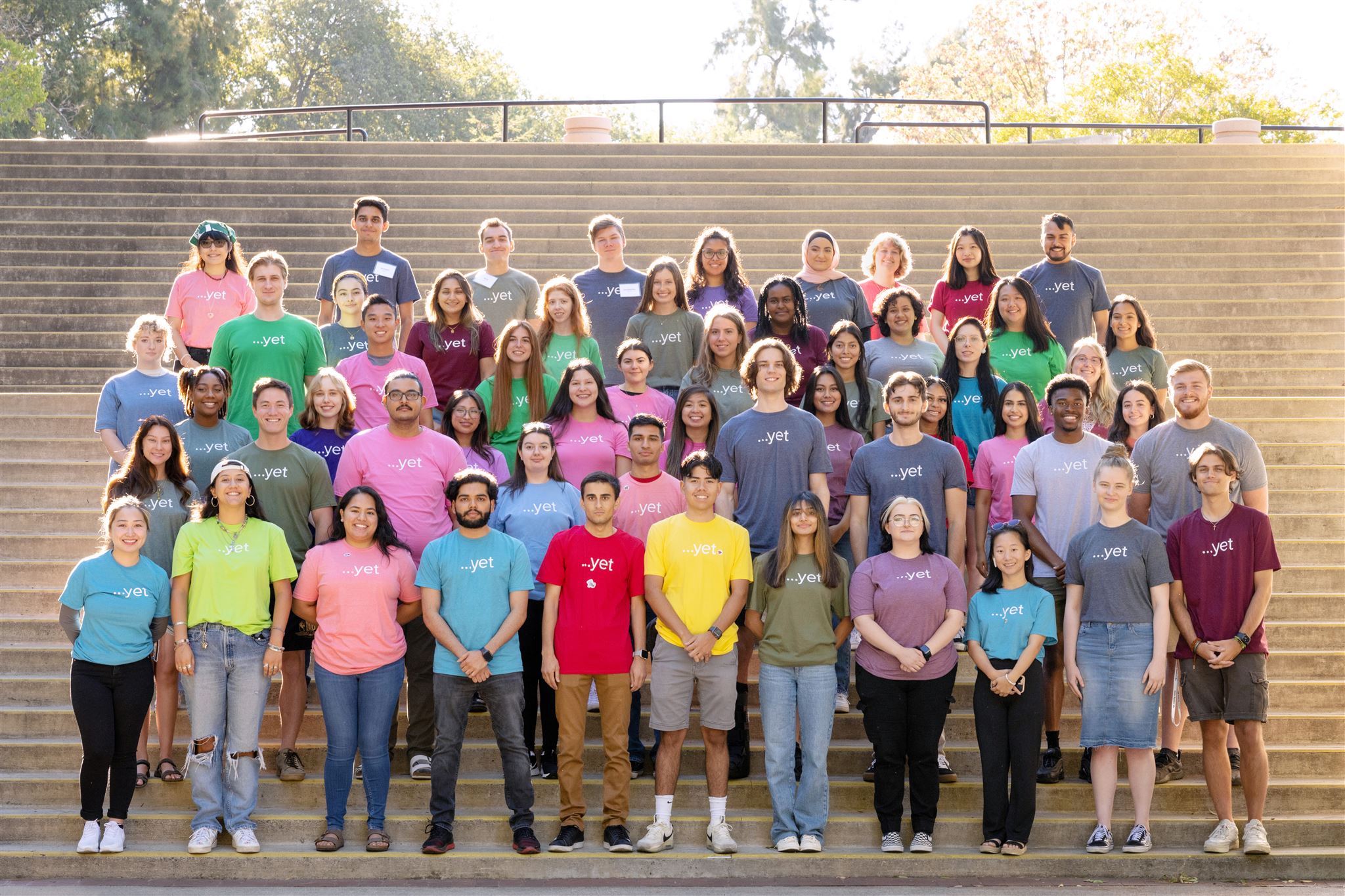
Publications and Grants
Papers (* denotes student author):
- Lundmark, Paradis, Tashiro, Kapp*, and Lowe*. Development and impact of a training program for undergraduate facilitators of peer-assisted learning. Journal of College Science Teaching (2017). A description of the PAL interview, training, and observation processes with an emphasis on developing student leaders.
- Shanbrom, Norris, Esgana*, Krauel, Pigno, and Lundmark. Assessing student success in a Peer Assisted Learning program using propensity score matching. Journal of College Science Teaching (2023). This statistical analysis indicates that students opting into PAL earn a 23% “bump” in their course grade; see graph above. This study considered data from over 25,000 Sac State students over 7 years. Since PAL is an optional program, this analysis used propensity score matching to compare students with comparable academic and social backgrounds, ensuring that the grade boost is actually due to the students' participation in PAL. The chart below shows the PAL bump in all classes with sufficient data after accounting for covariates. View the data for each class as R Markdown files here.
- Glass, Karl, Mazzag, Negri, Pilgrim, Shanbrom, and Thobaben. Peer instruction in mathematics: a survey of the California State University, PRIMUS (2025). Report describing the current landscape of peer instruction models for mathematics across the CSU system. Includes a comparison of programs, common values, goals and challenges, and recommendations for sustainably implementing and coordinating peer instruction.
- Perry and Shanbrom. The dosing effect of Peer Assisted Learning in undergraduate organic chemistry, Journal of Chemical Education (2025). Modern statistical analysis with propensity score modeling shows that students who took two organic chemistry PAL courses outperformed those who only took one by 0.58 grade points.
- Krauel and Shanbrom. The influence of a Peer Assisted Learning program on the career readiness of its student facilitators (submitted, 2025). Results of 2024 survey sent to ~400 former Facilitators now in the workforce, seeking to determine which PAL experiences contributed most to their workforce readiness and career success.
- Perry and Shanbrom. Propensity modeling of dosing in a Peer Assisted Learning program (in preparation). Analysis of large data set with propensity score modeling shows that taking more than one PAL makes the PAL grade bump even bigger, with an additive effect for each additional PAL taken.
Federal grants connected to PAL program:
- NSF STEP, Project Pass, $2.0M, 2011-2018, Established PAL and Commit to Study programs
- DoE Project INSPIRE, $2.4M, 2015-2023, Utilizing data analytics and peer programs to increase retention and graduation rates for students at Sac State
- NSF S-STEM, Hornet Science Scholars, $1.0M, 2016-2020, Optimizing academic, professional, and social aspects of STEM transfer, including addition of PAL to upper division courses frequented by transfer students
- NSF STEM, Project ASPIRE, $1.8M, 2020-present, Expansion of the PAL program to the College of Engineering and Computer Science and launch of STEM-wide Hornet Leadership Academy
- Department of Education, $5.0M, 2021-present, Further expansion of PAL program to courses serving health science majors and implementation of workplace skills development and leadership tracks within PAL
- NSF ELPSE, $500K, beginning 2026, Expansion of PAL program to transfer-level courses at CSUS and to a local community college, focus on math and stat